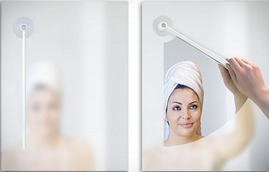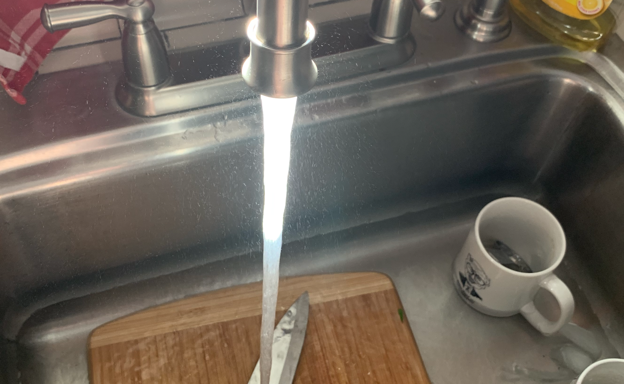Why doesn’t my bathroom fan prevent all that fog and condensation?

Answer:
Who told you it was supposed to do that?
One of the problems with our building code is that it doesn’t explain why any individual requirement exists, at least not in the text of the code. If you spend some money and go digging around, you can find commentary and explanations; not for everything, and in this hyperlinked age they don’t make it easy. So, why are bathroom exhaust fans required by code?
Ignoring condensation and foggy mirrors, sometimes I’m very thankful for those fans and in full agreement with that code requirement. Business stinks in bathrooms and an exhaust fan really helps with that. However, regardless of what you may have been thinking that time your knees buckled and your eyes watered, that stink is not fatal. To the best of my knowledge, no one on the receiving end of passed gas has ever even needed medical attention. One or two dry heaves maybe, that’s all. In fact, this exact topic was covered in episode 48 of the TV show MythBusters; also covered by Snopes: A Fart Attack is an offensive tactic, not a medical condition, and has nothing to do with foggy mirrors, usually. I’m in favor of the current code requirement for ventilation of bathrooms even if it’s only to deal with annoying odors but, perhaps there’s more to it than that.
When toilets are flushed, a plume of aerosolized particles is created. I’ve never counted but graduate students report there are over 100,000 such aerosolized water droplets created with each flush. Seems like a lot. Of course, those little airborne particles can have stuff in them that may be bad for our health, like nasty bacteria and viruses. However, as far as I know, toilet flush plume as a vector for disease transmission is still an untested hypothesis. During the Covid era, there were plenty of breathless “Experts say…” media articles on this subject but, all conjecture, no data. As for what is well supported by data, putting the lid down before flushing is super effective (at reducing the quantity of aerosolized particles) and fancy pressurized flush toilets (like those expensive ones that get specified in high-price, decorator designed projects) are worse than simple gravity flow toilets. Unfortunately, the code for public toilets does not allow the use of lids and most flushometer public toilets stir up extra-large plumes of aerosolized particles.
Now, I guess if those aerosolized plumes of pathogen polluted particles are sucked out of the bathroom through an exhaust fan you could make the case that this reduces your health risk, but it’s not so clear cut. Seems like the right thing to do but I don’t have any bathroom specific, cause-and-effect, or dose-response data to point to. Some whole-building studies, thanks to Covid, but no bathroom specific stuff. Again, requiring and using a bath exhaust fan seems like the right thing to do, and I’m in favor of it, even if it exists only do deal with those flush plumes, but, if this was discussed during the code adoption process, it must have been an interesting discussion.
Add a tub or shower to a powder room and the equation changes. Now we’re way beyond annoyance and into proper risk. That risk is related to water, and I don’t need to go sniffing around for non-stinky scientific studies to parse this risk. I only need to look in my own bathroom: it’s a daily and lifelong battle with mold and water damage. If I run my shower, or even draw a bath, the air in the room becomes thick with moisture – even when the window is open, and the fan is on. More on that later. Our building codes are littered with requirements intended to reduce risks brought about by water and, I believe, this is the better reason for bathroom exhaust fans and their code requirement. It’s about the water, and then, maybe the stink.
Ventilation is a time-honored method for drying and reducing moisture problems in buildings.[1] That is why bathroom exhaust ventilation is one of the design considerations for the control of condensation in bathrooms. The basic idea is simple: replace high moisture content air in the bathroom with lower moisture content air sucked in from some other area of the home. Then send that high moisture air out of the home. Simple. Eventually, that ventilation returns the bathroom to the same condition as all other areas of the home. Usually this works and is a slam-dunk success but, it’s not without some interesting considerations.
In years past, meaning before there was a building code for this sort of thing, bathroom exhaust rates were frequently designed at either 2.0 CFM per square foot of bathroom floor area, or 10 room-volume air changes per hour.[2] So, a 5’x7’ bathroom would have a design exhaust rate of either 2x5x7=70 CFM, or 10x5x7x8/60=46.6 CFM. There was no consensus as to which rate was better.
The current IRC code requirement for minimum bathroom exhaust ventilation in one-family dwellings is 50 CFM intermittent or 20 CFM continuous. Codification may, or may not be consensus but, at a minimum, it represents a strongly held recommendation by multiple respected practitioners in the industry.
There is no maximum ventilation limit in the code for bathroom exhaust ventilation in one-family dwellings.
There are, of course, practical and comfort considerations regarding maximum ventilation rate. A very high ventilation rate will waste energy, pollute the home during warm weather months (with overly humid outdoor air), desiccate the home during cold weather months, and be horribly uncomfortable for bathroom users (because standing in a breeze while dripping wet is miserable).
An “optimum” ventilation rate – something between code minimum and bad maximum – is subjective, not objective. Below is an incomplete list of variables that should be considered for the sort of calculation needed to determine such a ventilation rate:
- Exterior temperature.
- Exterior relative humidity.
- Interior temperature.
- Interior relative humidity.
- Insulating value of the bathroom walls, floors, and ceiling.
- Interior finish materials.
- Solar incidence.
- Body mass index.
- Occupant mood.
- Occupant diet.
- Water pressure.
- Shower head design.
- Shower water temperature.
- Shower operation duration.
- Shower operation frequency.
- Bathing water temperature (bath, not shower).
- Bathing duration (bath, not shower).
- Bathing frequency (bath, not shower).
- Personal comfort threshold for interior relative humidity.
- Personal comfort threshold for interior condensation.
- Undercut size on the bathroom door.
- Design of the shower stall/tub stall.
- Operation of the home’s HVAC system.
- Air sealing quality of the exterior walls.
- Air sealing quality of the interior walls.
- Window type.
There is no design algorithm, no equipment, and no mode of operation that can successfully accommodate all these variables. This is a common engineering problem – impossible. The accepted solution is to accommodate the typical, accommodate the reasonable, prevent the catastrophic, and acknowledge that it will not always work optimally. Keep in mind that NASA, with all the money and super-computing power in the world, can’t even figure out how to provide a proper shower for astronauts, and they don’t ventilate AT ALL.

Perhaps, if the issue were merely water vapor[3], the calculation would be easier. Unfortunately, water vapor is the least of it. When you see “steam” in a shower stall, or rising from a hot bath, or clouding the bathroom air, you are not seeing water vapor. You are seeing small water droplets, as in a cloud. Each droplet is typically a fraction of a micron in diameter – smaller than pollen, larger than a virus. Water vapor is clear and colorless, like clean, blue-sky, mountain-fresh air. If you can see the vapor, you are looking at water formerly known as vapor that has already condensed into tiny drops[4]. Those drops are so small, and so light they float – they are a colloidal suspension[5] – and they don’t fall to the ground like rain. As they float about, sometimes they re-evaporate and add to the water vapor content of the air, sometimes they collide with a surface and wet it, and sometimes they collide with other tiny droplets, combine to make bigger droplets that become too heavy to float, and fall to a surface. Those last two processes aren’t condensation, they are just wetting, like getting rained on. So, preventing condensation – if that’s one of the objectives of optimum ventilation rate – is even beyond condensation.
A crackerjack[6] design engineer would have a hard time developing a better system for rapidly increasing the moisture content of bathroom air than faucets and shower spray heads ejecting turbulent, broken streams of hot water onto bathers. Those fixtures create a continuous and enormous supply of microscopically small, warm water droplets. Way better than a toilet flush at putting water into the air.

Only those cool-mist systems at outdoor restaurants in hot places are better, and they’re outside (unlike those produce spray misters at fancy grocery stores).

Those mist particles are usually large enough and heavy enough to fall out of the air.[7] Of course, as they fall, they have plenty of time to evaporate. They do plenty of that, and that’s why they cool you off as you’re sipping cocktails outdoors in Phoenix – the thermal energy of the mixture is transferred from the hot air to the liquid water which then phase changes to gaseous water (water vapor). That loss of thermal energy from the hot air leaves it cooler. Evaporative cooling. That’s one of the reasons you feel cold when you’re wet and stand in front of a fan, and a good reason to wonder about where to place an exhaust fan in a bathroom.
If the water is hot and the air is hot and dry, those little mist droplets evaporate fast. If the water is cold and the air is cold and damp, they will evaporate slowly. And if air is moving through your bathroom from other areas of the home and out through the exhaust fan that changes the dynamics. And if the Sun is shining through the window and heating up one wall of the bathroom that changes the dynamics. And etcetera, etcetera, etcetera. For a better discussion of this complex process, I suggest starting with the climate change models.[8] If that doesn’t make you bat guano crazy, please come back and explain them to me.
During periods of cold weather, it is effectively impossible to prevent interior condensation in bathrooms when the shower or tub is used. In short, the rate of airborne water generation is greater than the rate of airborne water removal, and the temperature of the materials in the bathroom are below the dew point of the air in the bathroom. If the air in your home is super dry (think up in the mountains in a dessert, like Mount Charleston Village, Nevada) maybe you have very little condensation. If the air in your home is super humid (think over-humidified, fancy art collector’s house on the water in Martha’s Vineyard) maybe you have lots of condensation. No normally sized bath exhaust fan can prevent this condensation, you just can’t replace the moist bathroom air with dry house air fast enough.
During periods of warm weather, the conditions are about the same, only worse since the moisture content in the room air before the shower was turned on, and the ventilation air from other areas of the home, is already somewhat elevated (higher moisture content is more typical in warm weather periods vs. cold weather periods). Again, a normally sized bath exhaust fan can remove the moisture as fast as its created. Perhaps there’s a little less condensation on windows and other warm surfaces during warm weather months.
So, no matter what time of year, or what the weather, bathroom finishes will get wet with condensation. This is expected. We expect our bathrooms to get wet. Of course, unless the entire house is at 100% relative humidity, all that condensed water will eventually evaporate and disappear. We’ve all experienced this – things get wet, then, after a time, they dry out. And our homes are usually between about 20% relative humidity and 70% relative humidity – plenty of drying potential.
The only issue of concern is the duration of time that liquid water remains on finish surfaces. Liquid water that hangs around anywhere for too long is almost always problematic. Chemical reactions happen, things start to grow, etc. One bathroom design and operation objective should be to minimize this duration while recognizing that it is not possible to ever take this time to zero. And that’s why those fans are required – to reduce the risk of damage created by water that hangs around for too long.
What’s “too long?” Depends on the material. Too long for cold, vitrified clay (ceramic tile) might be several thousand years. Too long for wallpaper made with rice paste might be a few days (or a split second if it’s truly posh). Too long for a porous stone? Something between several thousand years and a split second – only experience and good judgement can help for some materials.
If a shower stall and bathroom’s finish materials are not moisture sensitive (i.e. not paper wallpaper or, perhaps, porous stone), if the finishes are maintained (cleaned regularly), if splash water on surround walls is reasonably removed after shower/bath use, if the bath exhaust fan is sized properly, and if the fan is operated for a sufficient period, the risk of problematic mold growth on bathroom surfaces, and other water related problems is very low. That’s why we don’t often see any problems in high price hotel bathrooms. Typical bathroom finish materials – ceramic tile, glass, non-porous stone, acrylic latex paint, wood, metal – are well suited for bathroom environments that experience brief periods of dampness followed by extended periods of drying.
“Sized properly” are, of course, weasel words, and have no definition. If the bathroom is “normal,” then a code compliant exhaust rate is proper. That’s my opinion. Condensation will occur, drying will occur, and the risk of problematic mold growth is minimum. If the bathroom is “more normal” [9] (maybe a double headed shower with multiple body spray jets, etc.) then an increase in exhaust rate, or multiple fans in different areas, can be considered. That is not strictly necessary since exhaust duration is also a significant factor, along with lots of other things but, it is a reasonable consideration. Of course, every other potential outcome from this increased exhaust rate should also be considered. It’s not a simple trade off and benefits must be weighed against adverse impact.
Where should that fan be in the room? Higher is better than lower since hot air (and all the water carried in it) rises. Farther away from the source of fresh air is better since this reduces “short circuit” air pathways. That source of fresh air, BTW, is usually the gap at the bottom of your bathroom door. Closer to the areas with the highest moisture content (like inside a shower stall) might be better but might reduce user comfort and might also not work so well for all those toilet related annoyances.
I know they help but, I don’t like it when the fan is on while I’m showering or drying off. I’m sensitive, and the air movement gives me an unpleasant chill. The dreaded “colpo d’aria[10].” No thanks. Tile the walls to the ceiling, finish the ceiling with epoxy paint and turn the fan on as you leave the room; that’s what works for me.
That’s about it for bathroom exhaust fans.
[1] Not everywhere, not all the time but, often and in many places.
[2] I never did these sorts of engineering calculations, so, these values come from a true expert: Andy Äsk. “H2NØ: Mechanical Systems and Moisture Control,” Building Science Press, 2008.
[3] Vapour for you truckers north of the 49th parallel.
[4] We usually think of condensation as something that happens on a surface, like a cold can of beer but, it can happen anywhere in any phase of matter.
[5] A suspension is a liquid or gas with particles mixed in that fall out when the fluid is allowed to stand, undisturbed, for a time. A colloid is a liquid or gas with particles mixed in that do not fall out when the fluid is allowed to stand. “Colloidal suspension” is not proper English, and I should write just colloid, or aerosol – a liquid dispersed in a gas. Colloids and suspensions are distinguished from normal-old mixtures by their ability to disperse light – that’s why martinis are clear, clouds are white, and Rudolf’s red nose was completely useless on that Christmas Eve flight.
[6] Cracker-jack predates Cracker Jack ™. The snack food got its name from the expression, not the other way ‘round. The “Prize in Every Box” came about even more recently.
[7] They are usually 10 microns, minimum – about the minimum size for something we can see as an individual particle. Cloud particle sizes can get rather enormous, and sometimes form up into balls of ice the size of baseballs but, that’s a crazy complex phenomenon that is only minorly like the conditions in your shower stall.
[8] https://climate.mit.edu/explainers/climate-models
[9] All bathrooms are normal, but some bathrooms are more normal than others.
[10] Gust of air, or punch of air is the strict translation but it’s a little more than that. There’s a sense of dread, or a little bit of Dark Ages evil wrapped up in that expression. Of course, un colpo d’aria could lead to un colpo di strega – the strike of the witch, AKA back pain.
